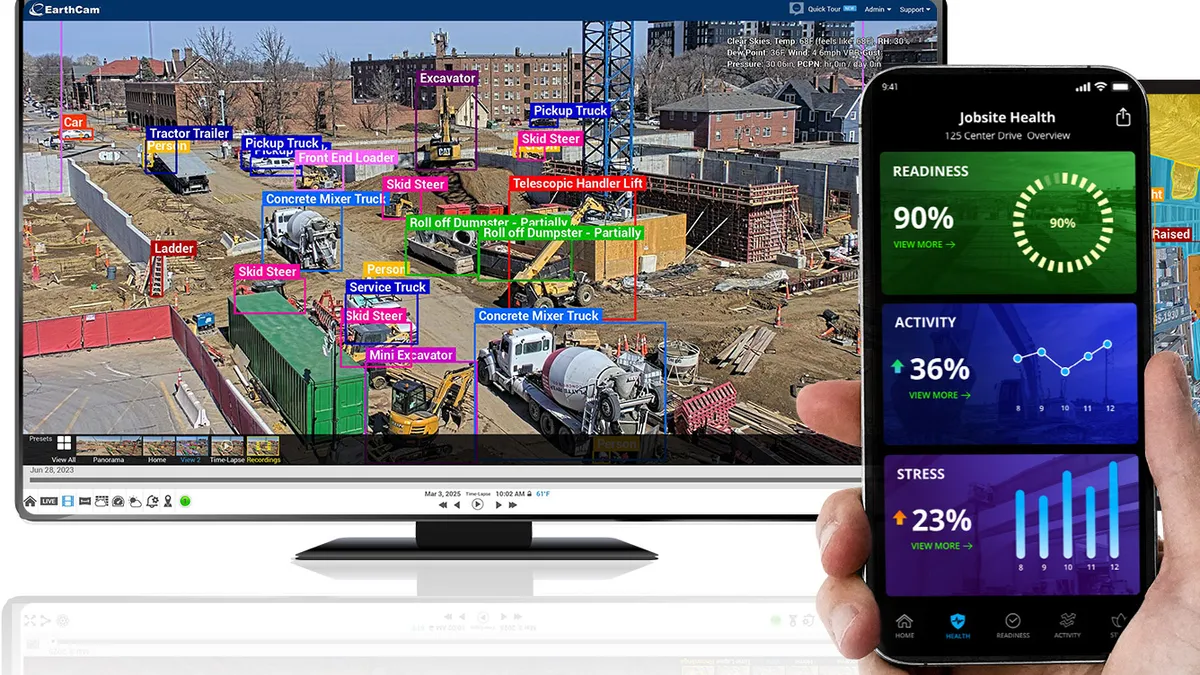Before the coronavirus outbreak began, Construction Dive sat with Katerra's senior director of construction operations, Rob Caputo, to learn more about how the prefab- and tech-driven firm views technology adoption and how it might compare to more traditional builders. The conversation has been edited for brevity and clarity.
CONSTRUCTION DIVE: Construction is often considered slow in technology adoption. What’s the most important way to get up to speed with tech?
ROB CAPUTO: That can mean a lot of different things depending on the size of the company. In some instances I think you've got [general contractors] that don't have an [enterprise resourcing planning (ERP) system] or a strong system to run their financials. They could be running QuickBooks, for instance. I think there's a lot of opportunity to look at how they manage their cost controls.
Or you could be a company that's a bit more sophisticated and has a bit more infrastructure in place in terms of the fundamentals. That then opens up different kinds of opportunities. It's identifying where your needs are, where your gaps are and where you stand to get the greatest return by enabling a solution. I don't think there's a one-size-fits-all, but a case-by-case evaluation of benefits.
What does Katerra do to keep up or get ahead?
CAPUTO: We've got a business model that is unique from the rest of the industry. Being vertically integrated opens up quite a bit of different opportunities for us in terms of tech enablement.
Outside of Katerra, your designer is [typically] an entity for the most part, your subcontractors are an entity for the most part. Each of those subcontractors have different suppliers that are entities. Then you've got the GC that's an entity. It is extremely fragmented. And for us being able to bring design, engineering, supply chain and general contracting all under one roof allows us a whole bunch of different solutions that no one else would be able to capitalize on.
So, we spend a lot of time looking at the value chain as a whole and then creating the prioritization around how we can integrate across all these different activities. Take SAP [Systems Applications and Products in Data Processing], for instance — that's our ERP. We've got factories, we've got warehousing, we've got distribution, we've got logistics. And so we've got a whole totally different set of requirements in terms of how we make that engine run. We've got an opportunity here by integrating that value chain and understanding where our priorities are.
When we get into Apollo — our software platform that we're developing — there's not a lot of off-the-shelf solutions that meet our needs because most are centered around the fragmented industry. You can get a lot of the same entities playing on the same platform, perhaps with a project management system, but the underlying processes are disconnected because everyone's got their own means and methods and then they come back together. So for us, when we look at this across a very holistic view, we're able to eliminate a lot of redundancy or inefficient process steps.
How do tech innovations or the way that you tackle them differ since you're using a different project delivery method than most?
CAPUTO: A manufacturing business cannot operate without a complete bill of materials. You've got to account for every single part and piece in order to feed the machine. You've got to go to a different level of detail than construction that’s traditionally designed. It's schematic in a way.
And then at the subcontractor level you've got people who have their detailers that kind of fill in the gaps beyond the initial concept. So they've got that level of information for the guys in the field that put all this together for the building product. We're bringing that level of design into the initial design.
We're not designing it and then passing it down the value chain and having someone come fill in the blanks. We're developing a complete bill of materials on the very front end as part of our actual design. We map that actual design file with SAP, and that's the engine that drives the supply chain. Then you take it one step further and we take our project schedules where we manage average delivery dates, all of the need-by dates — everything that's going to execute the job.
Once you update what’s required on-site for material, it then essentially automates the entire supply chain. The whole engine is driven off of SAP right now. That's why we'll focus on these building products. You've got a lot of work that goes into that front end, but once you do that, all you're essentially doing is updating dates and the whole engine is running on its own. We've got that information tied all the way to vendors.
Ultimately, we want certainty in terms of what it's going to cost to do “X.” We want to have certainty in terms of when we're going to be able to deliver for our customers. I think that's a challenge in itself in the industry: The lack of certainty around these things and variability is essentially accepted. What we're trying to do is engineer variability out of this entire engine. By connecting design to supply chain and to a project schedule and by taking this unique kind of approach to design and what we're offering to our customers, it gives us the opportunity to change the game.
How do you get more buy-in from stakeholders in the company or from clients?
CAPUTO: Internally we try to make sure we get good representation from various stakeholders on the front end, so they're part of the process. This approach can be challenging for people because having more people engaged initially creates kind of a perception of slowing progress or slowing down the process at first.
I don't think movement and progress are always synonymous. In the end, when you can get people on board on the front end to be part of it and to have a voice and have the right representation, I think the overall process becomes more effective. So, we spend a lot of time around making sure that you've got the right representation upfront and early on. It really needs to add value and it needs to help them and be effective down the road. And if it doesn't, what have we achieved?
In terms of our customers, it really just comes down to whether we are able to provide them a better service. If we're able to provide them a better service or a better outcome, then you engage in the solution. I think with technology naturally there's some people that geek out more than others. And so you might be talking to a customer and there might be just the novelty around it because what you're doing is cool, but in the end, I mean for collective buy-in to drive the solution, are you making their life better or not? Are you doing a better job or not?
Do you implement tech to see what problems it can solve? Or do you look at a problem then evaluate what tech can help solve it?
CAPUTO: I think the industry itself has a bit of a reputation as a laggard when it comes to tech, but I think that label is a bit misguided. It's my view that there's been significant efforts to bring technology and innovation into the space. The issue as I see it is there seems to be a lot more solutions looking for problems than vice versa. And I think, given that, there's a certain “wow factor” that individuals or companies can fall victim to when attempting to adopt a new solution. "It's neat, it's novel, it's cool, let's try it." But in the end, a company is in business to deliver for their customers and to generate returns for its stakeholders.
So when the wow factor doesn't deliver the result, ultimately you've just got another expense. You've got another thing you've got to manage. Over time, I think that's reduced various firms' appetite to adopt new technologies. Same with on the customer side, because if it's not driving that better result, what is it doing?
So our approach to technology is centered around identifying the problems we're trying to solve and then adopting the solutions that can aid in solving those problems. I think it really depends. No customer is a one-size-fits all.
We have certainty in costs, we have certainty in schedule, we have certainty in quality. And while that sounds basic enough, there's not a lot of certainty in our industry. [The construction industry] is labeled as continually running over budgets and continually running over schedules. That doesn't mean every project runs over budget or every project runs over schedule. But we do have a reputation of being inconsistent in terms of delivering on those things. We believe that we can deliver a building at a very competitive price point. And so our whole process, our whole approach to delivering the building products is around certainty and schedule cost and quality.





















